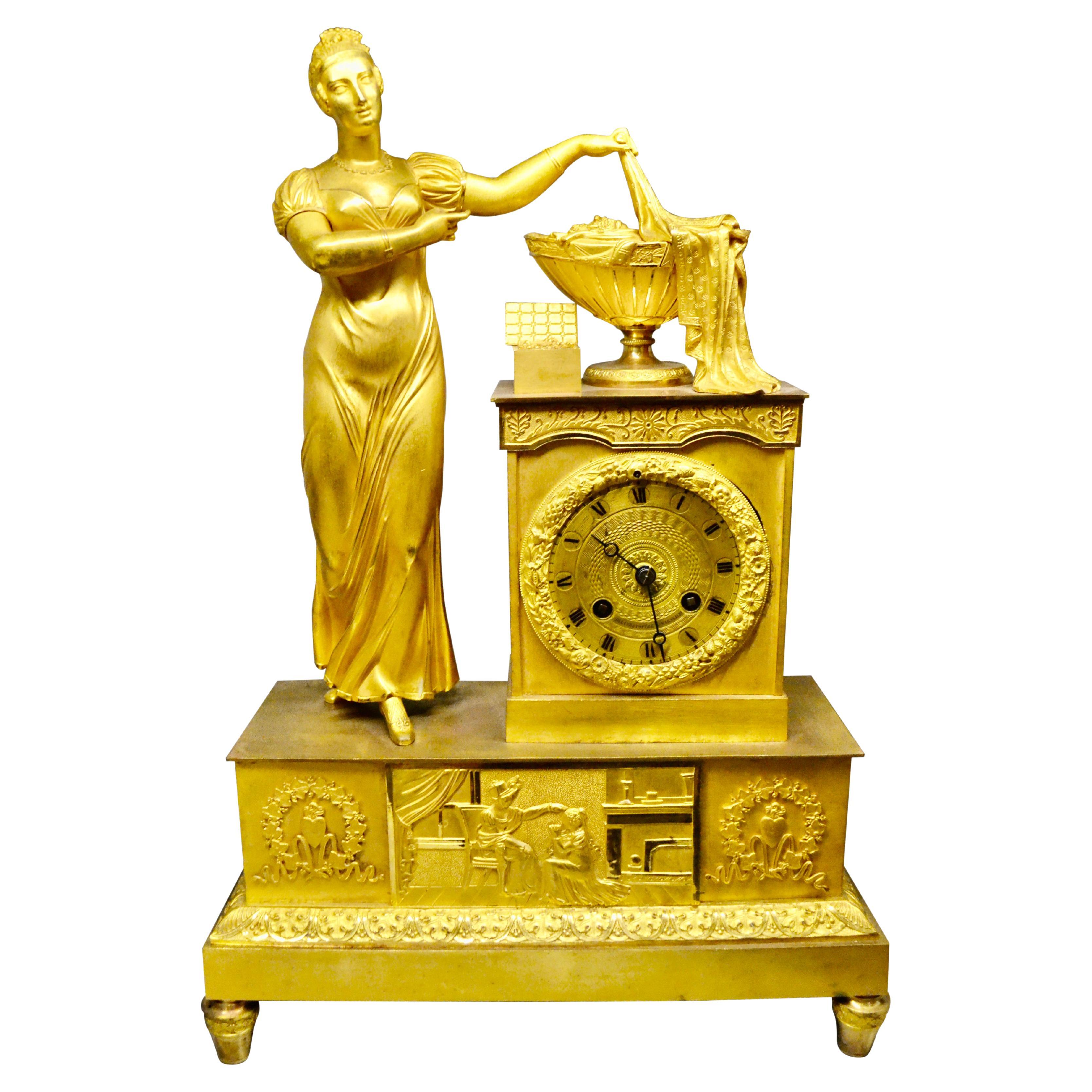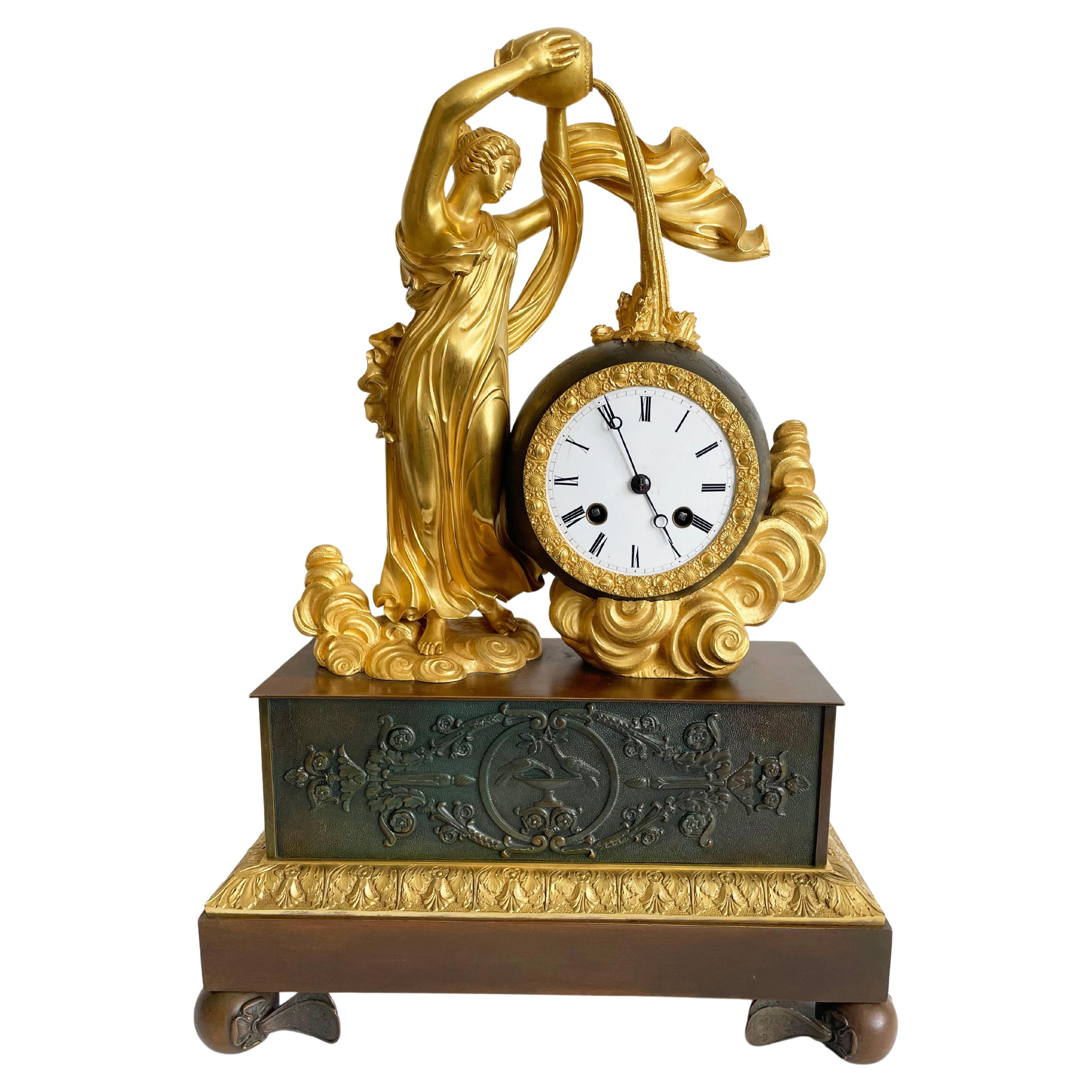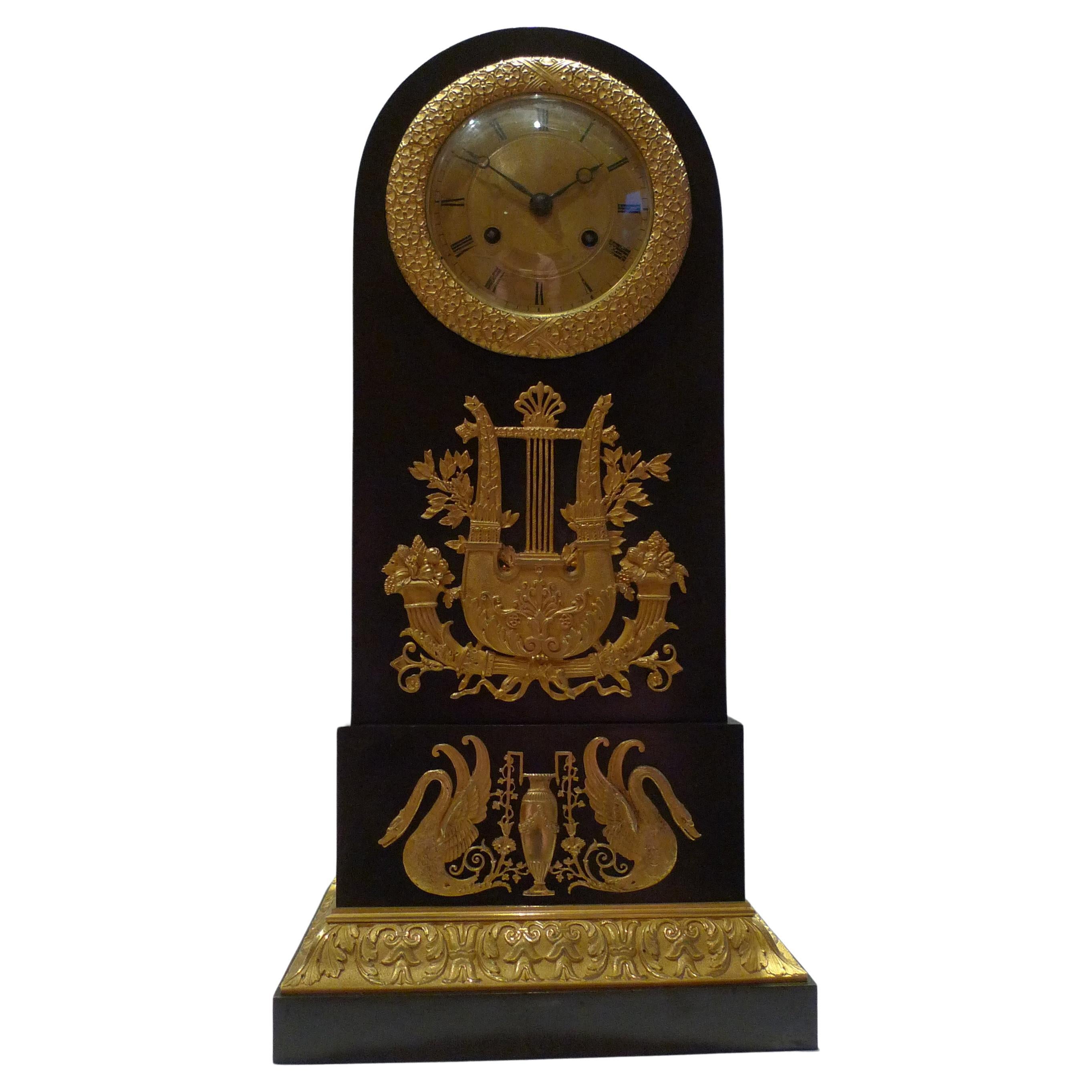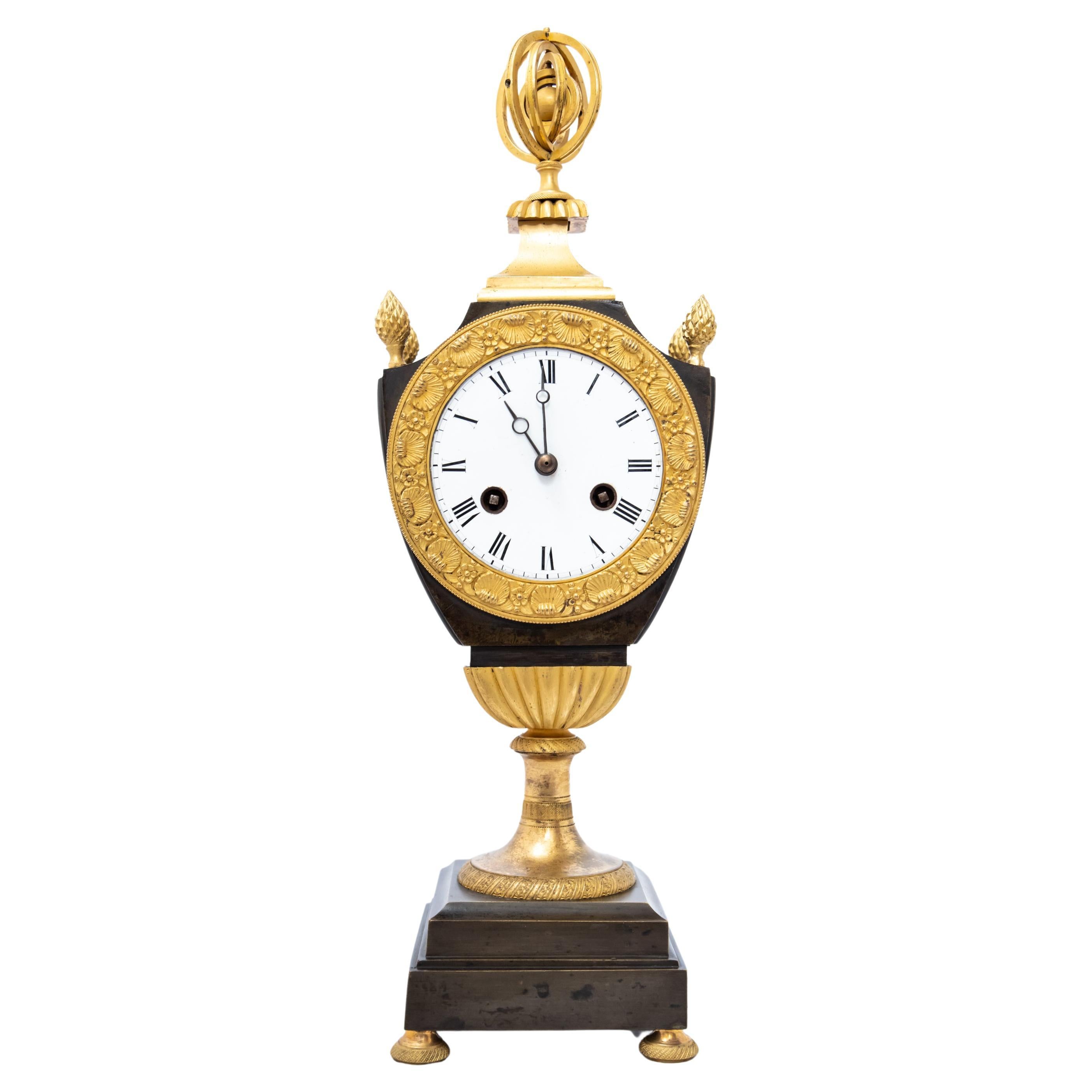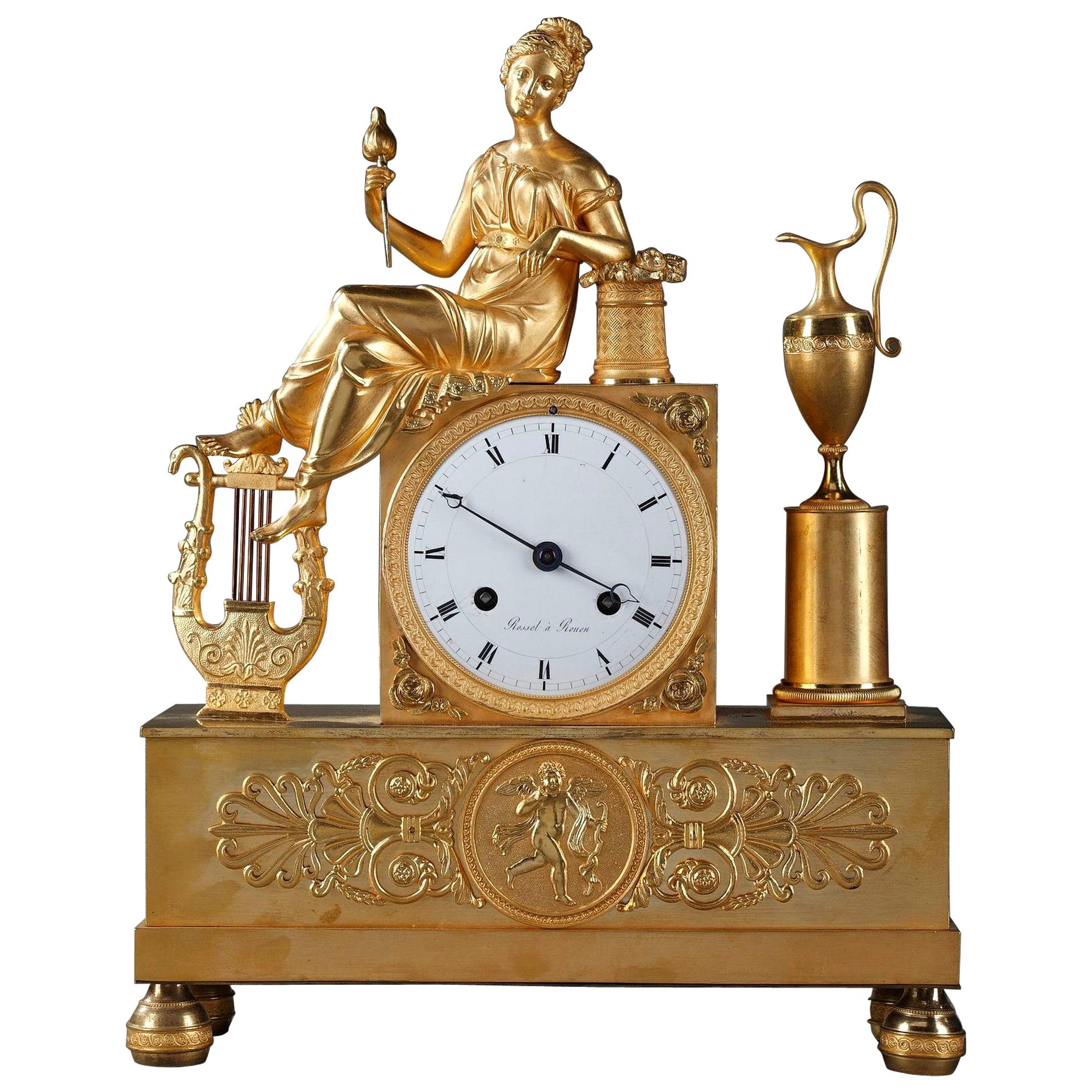Items Similar to Empire Clock in the Form of a Classical Urn, by Maison Lepautre, circa 1825
Want more images or videos?
Request additional images or videos from the seller
1 of 8
Empire Clock in the Form of a Classical Urn, by Maison Lepautre, circa 1825
About the Item
A gilt bronze Empire clock in the form of a classical urn, by Maison Lepautre.
French, circa 1825.
The dial signed 'Lepaute a Paris'.
The clock has an ornate cast bezel with a 3-inch porcelain dial with Roman numerals and Breguet style hands. The twin train eight-day movement with outside count wheel striking on a bell and silk thread suspension.
This elegant Empire style clock has a gilt bronze case in the form of a classical urn with swan neck handles and a winged cherub to the neck. The circular pedestal base is raised on a footed stepped square plinth.
The Lepaute family were the premier French clockmakers of their day. Their significance lies in their contribution to the clock making industry which had hitherto come under the trade of locksmiths. The family held the brevet Horlogers du Roi.
Jean-André Lepaute (1720–1789) arrived in Paris at an early age and in 1740 founded the family business. A skilled artist and mechanic, he quickly gained an excellent reputation. He was received as maître by the clockmakers guild in 1759, was granted royal lodgings from the king in The Luxembourg Palace, and was entrusted with the construction of the majority of the great public clocks of Paris. He executed, amongst others, those in The Luxembourg Palace, the Jardin des Plantes, the Château de Bellevue and the Château des Ternes. His clock at Paris’s École Militaire still works today. Three editions of his Traité d’Horlogerie were published in Paris in 1755, 1760 and 1767. A small volume, Description de Plusieurs Ouvrages d’Horlogerie appeared in 1764. Jean-André’s wife, Nicole-Reine Etable de la Brière (1723-1788), was a highly esteemed mathematician and astronomer. Her passion for science lent itself to Lepaute’s work and she played an active role in the scientific and mathematical aspects of the clock making.
Jean-André’s younger brother Jean-Baptiste Lepaute (1727-1802) joined him in Paris in 1747 and immediately started working for the family business. He was received as maître in 1776 and was known for the clocks he constructed for the Paris Hôtel de Ville (1780), destroyed in a fire of 1871, and for the Hôtel des Invalides (1784). Jean-Baptiste took over the workshop when Jean-André retired in 1775.
After Jean-Baptiste’s death in 1802, the firm was taken over by his nephew Pierre-Basil Lepaute (1750-1843) where he was duly joined by his own nephew Jean-Joseph (1768-1846) and son Pierre-Michel (1785-1849). By 1816, Pierre-Michel Lepaute was in charge of the business. His masterpieces include the astronomical clock in Paris’s Bureau des Longitudes and those in the city’s Bourse (stock exchange), the Hôtel des Postes, the Louvre Palace, the Tuileries Palace and the Château de Compiègne. Pierre-Michel invented the horological principle of ‘remontoir d’égalité’, a force mechanism which is still used by clockmakers today. From 1862 until 1867 the company was run by Pierre-Michel’s two sons Léon Henry-Lepaute and Paul Henry-Lepaute.
- Creator:Pierre-Basile Lepaute (Clockmaker)
- Dimensions:Height: 13 in (33 cm)Width: 6.7 in (17 cm)Depth: 3.94 in (10 cm)
- Style:Empire (Of the Period)
- Materials and Techniques:
- Place of Origin:
- Period:
- Date of Manufacture:circa 1825
- Condition:
- Seller Location:Brighton, GB
- Reference Number:
About the Seller
5.0
Recognized Seller
These prestigious sellers are industry leaders and represent the highest echelon for item quality and design.
Platinum Seller
These expertly vetted sellers are 1stDibs' most experienced sellers and are rated highest by our customers.
Established in 1964
1stDibs seller since 2014
48 sales on 1stDibs
Typical response time: 1 hour
Associations
The British Antique Dealers' AssociationLAPADA - The Association of Arts & Antiques Dealers
- ShippingRetrieving quote...Ships From: Brighton, United Kingdom
- Return PolicyA return for this item may be initiated within 7 days of delivery.
More From This SellerView All
- Empire Gilt-Bronze Clock Depicting Diana the Huntress. French, c 1820Located in Brighton, West SussexA fine Empire Period gilt bronze clock depicting Diana the huntress. The dial signed 'Thomas a Paris'. The white enamel dial with Roman numerals and Breguet hands, the case sur...Category
Antique Early 19th Century French Empire Mantel Clocks
MaterialsBronze
- Louis XV Style Bronze Figural Clock Garniture by Maison Baguès French circa 1870By Maison BaguèsLocated in Brighton, West SussexA fine Louis XV style gilt and Patinated bronze figural clock garniture by Maison Baguès. This rare example of a clock garniture by Maison Baguès has a twin train eight-day movement striking on a bell. The garniture consists of a clock and a pair of candelabra en suite. The clock has a Rococo cast case surmounted by a patinated bronze putto playing a lyre, above a circular white enamel dial with Roman numerals, Arabic seconds and pierced hands. The dial inscribed 'Eug Bagues, Paris'. The case terminates in four scrolling legs put down on an acanthus cast plinth base. The candelabra en suite have gilt bronze pierced acanthus cast bases supporting patinated bronze putti each holding aloft three scrolling acanthus arms terminating in circular and foliate cast drip trays and nozzles. Maison Baguès The Baguès Company, located at 31, rue des Francs-Bourgeois, was founded in 1840 by Mr. Noel Baguès who started his business to cast liturgical bronzes. By 1880 the company had expanded into the production of bronze light fixtures in response to the development of electrical lighting. Carried on by Noël’s son Eugène and grandsons Victor and Robert, Maison Baguès continued to progress, adding intricately detailed iron lighting collections in the 1920s as well as stair banisters...Category
Antique Mid-19th Century French Louis XV Mantel Clocks
MaterialsBronze
- Louis XVI Style Annular Dial Clock in the Manner of Lepaute, French, circa 1890By Jean-André Lepaute 1Located in Brighton, West SussexA rare Louis XVI style gilt-bronze mounted marble annular dial pedestal clock in the manner of Jean-André and Jean-Baptiste Lepaute, attributed to Dufaud, Paris. The eight-day twin-train movement with circular plates and lateral lever escapement on a gilt platform, with cut bimetallic compensation balance, flat balance spring and index regulator, striking the hours and half-hours on a bell. The dial having twin revolving chapter rings with white enamel cartouches with Roman numerals on a revolving ring, with a revolving minute ring above with Arabic numerals, the time indicated by Cupid pointing with an arrow. This fine annular dial or ‘cercles tournants’ clock...Category
Antique Late 19th Century French Louis XVI More Clocks
MaterialsMarble, Bronze
- Louis XVI Style Porcelain Mounted Figural Clock, Allegorical of the ArtsLocated in Brighton, West SussexA Louis XVI style gilt bronze and Sèvres style porcelain mounted figural clock, Allegorical of the Arts. The dial signed 'Colin, Paris'. The movement stamped 'Vincenti et Cie'. ...Category
Antique 19th Century French Louis XVI Mantel Clocks
MaterialsOrmolu
- Fine Gilt-Bronze and Champlevé Enamel Clock, circa 1880Located in Brighton, West SussexA fine gilt bronze and champlevé enamel clock. French, circa 1880. The movement with impressed stamp to the backplate 'Vincenti et Cie 'Médaille D'Argent 1855', 'PARIS'. Thi...Category
Antique Late 19th Century French Mantel Clocks
MaterialsBronze, Enamel
- Louis XVI Style Gilt Bronze and White Marble Clock By François Linke, circa 1890By François LinkeLocated in Brighton, West SussexA fine Louis XVI style gilt bronze and white marble clock depicting Diana and Cupid, by François Linke. French, circa 1890. Signe...Category
Antique Late 19th Century French Louis XVI Mantel Clocks
MaterialsMarble, Bronze
You May Also Like
- Empire Gilt Bronze Clock of Standing Classical Lady Unveiling an Urn of PlentyBy A. RavrioLocated in Vancouver, British ColumbiaA late French Empire mantle clock in gilded bronze depicting a standing classical lady on the left side of the clock plinth with her left ar...Category
Antique 1820s French Empire Mantel Clocks
MaterialsBronze
- Empire Table Clock, Patinated and gilded bronze, Cleret, Paris, Circa 1825By CleretLocated in Melbourne, VictoriaFrench Empire table clock by Cleret, Paris, movement by Pierre-César Honoré Pons. The case in gilded and patinated bronze, circa 1825. The bronze base is decorated with a broad floral frieze with a central urn and two doves above a gilt floral border on four ball feet, the front feet with butterfly wing decoration. On the top of the clock stands a gilt bronze figure of a classically dressed maiden pouring...Category
Antique Early 19th Century French Empire Mantel Clocks
MaterialsBronze
- Empire Clock The Spinner by Rossel in RouenLocated in Paris, FRFrench Empire pendulum clock finely crafted of gilt bronze, featuring a young spinner wearing a classical dress, seating on the dial near a lyre ...Category
Antique Early 19th Century French Empire Mantel Clocks
MaterialsBronze
- French Mantel Clock of Empire Period of "Borne" FormLocated in London, GBAttractive french Empire clock in patinated bronze and ormolu of milestone or "borne" form. Having very fine applied ormolu mounts to the front and side of the case with also a fine ...Category
Antique 1810s French Mantel Clocks
MaterialsBronze, Ormolu
- Patinated and Fire-Gilt Clock in the Form of a Vase c. 1800Located in 263-0031, JPA French patinated and fire-gilt clock in the form of a vase, Empire Era, 1800-1815. The silk-thread mechanism is in good working condition with key and pendulum.Category
Antique Early 19th Century French Empire Table Clocks and Desk Clocks
MaterialsBronze
- Empire Pendulum Clock the Spinner, Signed Rossel in RouenBy Rossel in RouenLocated in Paris, FRFrench Empire pendulum clock finely crafted of gilt bronze, featuring a young spinner wearing a classical dress, seating on the dial near a lyre ...Category
Antique Early 19th Century French Empire Mantel Clocks
MaterialsBronze
